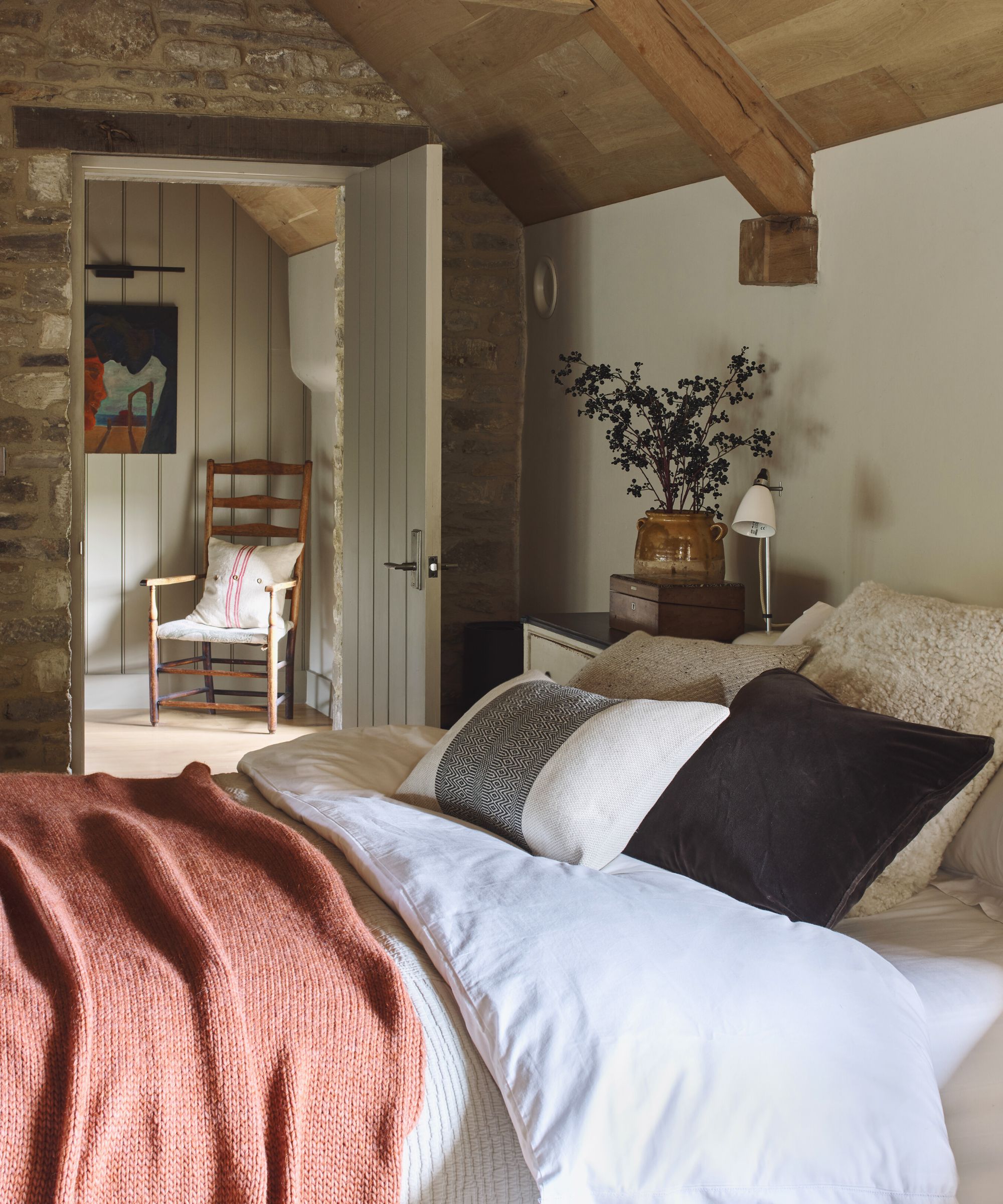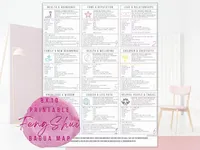The Feng Shui energy map explained – and how to apply it at home
Could your home benefit from the Feng Shui energy map? Experts explain all


If you are new to Feng Shui, then all the talk of energy and active corners can sound pretty confusing. One of the most important aspects of Feng Shui to understand is the Feng Shui energy map, but it is also one of the more complicated aspects to get your head around.
Also called the Bagua map, it is a major component in the meaning of Feng Shui and is essential for good Feng Shui furniture placement.
Here, Feng Shui experts have explained the Feng Shui energy map, how to use it in your home, and why it could benefit you.
What is the Feng Shui energy map?
The Feng Shui energy map is a tool used in Feng Shui practice to analyze the energy flow and balance within a space. It can be used to help channel energies to one particular life concern or simply to create good Feng Shui in your home.
The Bagua or energy map consists of nine areas, set out in a grid, each representing a different aspect of your life, also called ‘Guas’, explains Matthias Dettmann, psychologist, and Feng Shui teacher.
This ‘symbolic representation of our lives and the energy of each space’ can be used to find balance deficits in the home which may correlate to difficulties faced in everyday life, says Maureen Calamia, Feng Shui practitioner and co-author of Creating Luminous Spaces, a harmonious Feng Shui living guide available at Amazon. Feng shui consultants use the map to ‘look at the home, or workspace, and look for metaphors of the floor plan and our client's experience in that space.’
‘For instance, someone that has challenges with finances will often be drawn to a house that lacks in the Feng Shui wealth corner. This lack of support in this area of their lives resonates with their own personal energy field. The correlation between these two deficits is not causing the issues in the inhabitant's life, however, it is mirroring it in a symbolic way,’ she explains.
Design expertise in your inbox – from inspiring decorating ideas and beautiful celebrity homes to practical gardening advice and shopping round-ups.

Maureen Calamia is the co-author of Luminous Spaces, and an experienced Feng Shui practitioner and public speaker. She works to inspire others to discover and connect with nature in their every day lives through the five elements and Eastern philosophy.
The Feng Shui energy map areas

There are eight areas on the energy map with a ‘ninth area where all the other areas and their energies intersect,’ says Maureen Calamia, a Feng Shui practitioner. The quadrants correlate to:
- Career - north
- Knowledge - north east
- Family - east
- Wealth - south east
- Fame - south
- Love - south west
- New beginnings - west
- Travel - north west
- Health and Balance - center
‘Each area is then also associated with specific colors, elements, shapes, and symbols, which can energize or activate the area,’ furthers Matthias Dettmann, Feng Shui teacher. This can help to dictate your Feng shui bedroom layout, for example, or where to place your sofa for Feng Shui.

Matthias Dettmann is a trained psychologist, PMR coach, and trainer with years of experience in using Feng Shui to empower people in their everyday lives. He likes to combine the scientific aspects of psychology with the spiritual elements of Feng Shui and tarot to help people find balance.
Why the Feng Shui energy map is important

If you are looking to make your Feng Shui house happy, then the energy map or Bagua map could play a huge role, experts suggest. Using the Bagua map helps practitioners and clients to locate ‘the areas of a home which relate to the nine important areas, and notice which need action to improve the energy and help occupants to thrive,’ explains Suzanne Roynon, Feng Shui practitioner and designer at Interiors Therapy.
‘As a Feng Shui practitioner, the Bagua map is my favorite tool to use because it gives so much identity and awareness not only to the blockages in your home but also allows for a deeper connection and awareness to yourself,’ continues Kate Troyner, Feng Shui practitioner at Home Slice Living.
‘By understanding the energy centers of your home and how they correspond to different areas of your life, you can gain insight into your own strengths and challenges. Our homes are constantly showing us where we can make improvements in our life or giving us ah-ha moments. The Bagua map is a powerful tool for bringing this awareness to the forefront and empowering you to make positive changes in your life.’

Kate Troyner has always been curious about how the home environment reflects how you are feeling and the outcome of your day. She is the creator of the Homes Wellness Collective and dedicates her life to empowering clients though Feng Shui and beautiful spaces.
How to use the Feng Shui energy map

Once you understand the areas and meanings of the Feng Shui energy map, then using it in your home is a lot simpler. Feng Shui experts Maureen Calamia and Suzanne Roynon say there are two ways you can do this.
The first way to use the map is to channel traditional Feng Shui teachings, they say. This involves using a compass to orient the grid so that the career and life path is in the northernmost part of the room or home and the rest of the grid falls naturally from there.
A more modern approach focuses on the layout of the room. In this instance you should align the bottom of the map with the front door of the room or home, says Matthias Dettmann, Feng Shui teacher. ‘The Career area should be at the door, with the other 'guas' placed in their corresponding locations around the map,’ he adds. This stands true for every room in the house, from living room Feng Shui to office Feng Shui. You can even use Feng Shui to turbocharge your home's energy for festive hosting.
Printable and Digital Feng Shui Bagua Map | $6.27 at Etsy
This Bagua map guide will help you to select the right artwork and decor for each Bagua area for great energy flows in any space.
Once you have oriented the map, it is time to apply it to your space. The best way to do this is to lay the map over the top of a room or floor plan of your home, says Suzanne Roynon. ‘Lots of homes have a floor plan drawn by an estate agent or architect,’ she says, ‘but if one is not easily available, use a tape measure or just pace out the rooms and draw the most accurate plan you can onto a piece of squared paper.
‘Draw a "noughts and crosses" or "tic tac toe" which looks like a large hashtag with nine equal sections over the floorplan. Depending on the shape of the house, these will either be nine equal squares or oblongs,’ she explains.
Depending on which method you are following, the traditional or modern Western school of Feng Shui divides the grid into squares starting either with the career space by the door or in the most northern spot.
Now you can start to see which areas need attention in the space by walking around your home with the map and paying close attention to what is happening in each area in terms of decor, clutter, and how you feel in that area.

Suzanne is a specialist Interiors Therapy Expert and author of Welcome Home, How Stuff Makes or Breaks your Relationship – available on Amazon. She has spent more than 25 years in corporate and charity roles, using her ability as a therapist and public speaker to help people understand their relationship with their homes and possessions.
The benefits of using the Feng Shui energy map

There are several supposed benefits to Feng Shui and the energy map can help people to unlock their space’s potential.
‘By using the Bagua map, you can identify areas of your home that may be hindering your progress in certain areas of your life and make changes to promote positive energy flow,’ says Kate Traynor. ‘Using this tool really can provide you with countless benefits, from attracting healthier relationships to experiencing windfalls of opportunities. By understanding the energy flow in your home and making changes to promote positive energy flow, you can create a harmonious living space and a better life.’
Homes & Gardens section editor Millie Hurst says applying the Bagua map to your space can make things feel more aligned. 'I keep my suitcases and a small storage basket with my passport, foreign currency, and kindle in the 'travel' Bagua of my apartment,' she says. 'It lines up with a big closet so it works in my space, which means everything is together when it comes to packing, and I like to think it means I'm open and ready for any opportunities to travel that come my way.'
FAQs
How can I attract positive energy with Feng Shui?
One of the best ways to attract positive energies in Feng Shui is to declutter and simplify your home. Doing this can open up the flow, helping you and your energy move more freely around a space, and help to boost mood, attracting more positive life opportunities.
What are the five elements in Feng Shui?
There are five elements in Feng Shui comprising fire, earth, metal, wood, and water. These elements can be used to channel different energies such as passion or calmness and can be combined with color to bring balance to a space to improve harmony in your home and, as a result, your life.
If you feel ready to take your Feng Shui practice beyond simple Feng Shui mirror rules and Feng Shui TV placement advice, the Bagua energy map could be the perfect step to creating good energy in your space.

Chiana has been at Homes & Gardens for two years and is our resident 'queen' of non-toxic living. She spends most of her time producing content for the Solved section of the website, helping readers get the most out of their homes through clever decluttering, cleaning, and tidying tips. She was named one of Fixr's top home improvement journalists in 2024.
